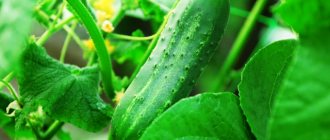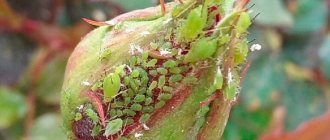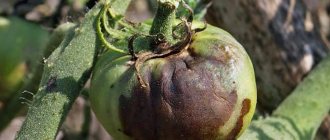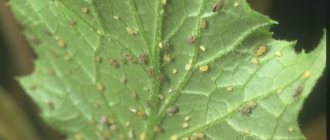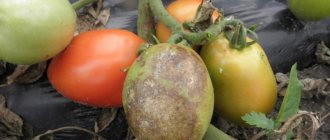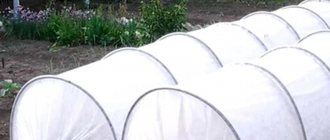Late blight is a dangerous disease.
With high humidity and poor air circulation, which is typical for greenhouses, the disease develops very intensively. Many vegetable crops are affected by fungal spores. Cucumbers are no exception. The main danger of the disease is its rapid spread. If treatment of affected plants is not started promptly, they may die. Dear readers! For you, we have created communities on social networks in which useful articles and interesting ideas are published several times a day! Subscribe and receive useful content in a convenient format!
Late blight on cucumbers and peppers
The development of phytophora on cucumbers and peppers occurs gradually and at first it is even difficult to identify this disease. And once the fungus has reached the crop, it is difficult to change anything. Therefore, experienced gardeners recommend taking preventive measures to prevent the occurrence of a dangerous disease.
Late blight is caused by the fungus Phytophthora infestans, which reproduces asexually. The spores tolerate temperature changes well and overwinter in the soil, and with the onset of stable heat of +17-+25 degrees they begin to grow rapidly. High humidity promotes good development of fungal mold, which is why strong outbreaks of late blight are observed after rains.
Signs of late blight on cucumbers and peppers
Late blight begins to actively appear at the end of summer. It looks like brown rotten spots on leaves and stems. If treatment is not applied, brown spots begin to cover the fruits.
The photo shows late blight on a cucumber
The photo shows late blight on pepper
Late blight looks like brown rot, which first affects the lower tier of leaves, and then rises up the stem to the fruits. Affected leaves shrink and dry out, so gardeners often do not attach importance to the problem and confuse it with a lack of watering. But here lies the main problem, since with increasing watering the humidity increases, which, in turn, contributes to the development of spores.
What is the danger
Late blight itself is not dangerous to humans. You can safely eat fruits affected by late blight. However, no one wants to eat rotten cucumbers and other vegetables. In addition to their unattractive appearance, they also have a corresponding smell. Cucumbers from an already cured bush also look unappetizing. They are unevenly colored and have bumps.
The danger lies in the survivability of this type of fungus: it is not afraid of cold and heat. Once faced with this disease, summer residents then try for years to remove it from the site.
The disease affects cucumbers, tomatoes, eggplants, and potatoes. Affected plants do not bear fruit: tomatoes do not turn red, cucumbers do not set, potatoes lose their tops and do not form tubers. The result is a meager harvest or its complete absence.
Reasons for the development of late blight
Even if late blight treatment was carried out successfully, it will arise again next year if the reasons why its active spread begins are not eliminated. The main reasons are:
- Close proximity of bushes and, as a result, disruption of free air flow;
- Neighborhood with potatoes or tomatoes;
- Lack of heat and differences in night and day temperatures;
- Increased precipitation;
- Excessive fertilization with nitrogen substances;
- Excess lime in the soil;
- Watering is carried out not under the bush, but on the leaves;
- Lack of beneficial microelements, resulting in weak immunity in plants.
How can you increase the effect of antibiotics?
To increase the destructive effect of metronidazole on pathogenic bacteria, it is worth adding a little pharmaceutical green to the solution. For 10 liters of liquid, it is enough to pour one bottle. Both surfaces of the leaves need to be treated with this product.
Iodine has a similar property. It also requires one bottle per 10 liters.
When adding iodine or brilliant green to the solution, the concentration of the antibiotic should be lower. It is recommended to stir no more than 10-15 tablets in 10 liters of water.
A little more about the adaptation of microorganisms to antibiotics
To avoid harmful microorganisms becoming accustomed to the effects of metronidazole, spraying should be alternated with the use of other means of protection. Here are two of the most effective step-by-step recipes.
- Grate 50 gr. peeled garlic cloves, pour them with a liter of fermented kefir and leave at room temperature for a day. Then strain the infusion, squeeze out, dilute with ten liters of clean water. After this, the product is ready for use.
- This recipe is much simpler, and its effect is no worse than the first. In a liter of whey you need to dissolve 25 grams of iodine and add 10 liters of water.
The technology for using both drugs is the same. They are sprayed on tomatoes using a garden sprayer.
Prevention of late blight
Preventative measures take some time, but it is better to spend it on preventing the disease than trying to save a rotting crop. The first thing to do when late blight is detected on your site is to destroy all affected leaves and stems after harvesting. It's best to burn them. The material that served as support for the bushes (wire, stakes, ropes) must either be processed or also burned.
Watering should only be done under the bush. If you water from above on the leaves, the spores penetrate better into the stomata of the plants. Excessive watering is also not necessary, since high humidity promotes the development of fungus. This also applies to seedlings in a greenhouse. It should be noted that the greenhouse especially needs good ventilation, since the air there is prone to high humidity.
Also, soda or soda solutions are used as bait. Soda has an antibacterial effect on fungi and plants become more resistant to attacks by various fungal diseases.
Symptoms of infection
Visible signs of late blight begin to appear in mid-summer. Unfortunately, the initial stage remains unattended for one simple reason - we do not bother to look closely at the condition of young bushes and do not examine the leaves from the back side.
We recommend reading: Diseases of cucumbers.
This is the process that occurs from the moment of infection until the complete destruction of the crop: first, the fungus affects the underside of the leaves, resembling white translucent mold or thin padding polyester. As the disease develops, through brown spots appear on the leaves, lumpy in structure. These spots grow over the entire area of the leaf and completely dry it out. The fungus then moves along the stems until it turns the entire bush into a herbarium. When late blight infects fruits, rotting begins. At the same time, new ovaries stop forming and you can forget about harvesting.
What does photofluoria look like on cucumbers - Photo
If diseased bushes and their roots are not removed from the site in time, they will begin to crumble and crumble to the ground under the influence of the wind, penetrating deep into the soil with rain. Late blight is also transferred to the soil along with them. To use such a plot of land again, it is necessary to carry out thorough treatment and disinfection.
Methods to combat late blight
The use of fungicides is the main control measure against late blight at the active stage, when most of the plant is affected. They effectively act on the source of infection, destroying fungal spores. They can be used a limited number of times, as they contain toxic substances that can accumulate in the fruits. And this, in turn, is very harmful to humans. The processing procedure itself also requires attention and full compliance with safety measures. It is imperative to protect the skin and try to avoid contact with chemicals on the mucous membrane. Prepare all formulations strictly observing the proportions and adhering to the description, since a small amount of the substance may not work, and abuse is fraught with negative consequences.
Seeds for seedlings are soaked in a weak solution of potassium permanganate. Then they water it after planting in the ground, when the seedlings have sufficiently taken root and taken root.
Suitable preparations for processing cucumbers and peppers are Arcedil (50 g per 10 l of water), Ridomil RC (25 g per 10 l) and Oxychom (20 g per 10 l). For spraying leaves, Ditamine (20 grams per 10 l of water), Fitosporin (10 g per 10 l), copper oxychloride (40 g per 10 l of water) and cuproscat (25 g per 10 l) are used. A positive effect also occurs from copper sulfate, Bordeaux mixture or potassium permanganate solution.
Using furatsilin is a simple and effective way to get rid of phytosporosis. The solution is prepared in the proportion of 10 furatsilin tablets per 10 liters of water. Spraying is carried out 3 times: before flowering, at the first ovaries and at the beginning of the appearance of cucumbers or peppers.
Mistakes when growing cucumbers
Most often, the spread of late blight is provoked by incorrect human actions. Due to inexperience or ignorance, he performs a number of actions that contribute to the spread of pathogenic microorganisms.
It may be interesting What fertilizers to use to feed cucumbers in a greenhouse How to use cucumber nitrate as a fertilizer We plant cucumber seeds as seedlings and in open ground according to the lunar calendar
- Incorrect watering. Very often, cucumbers are watered according to a schedule, without taking into account the condition of the soil and plants, which creates a favorable environment for the development of spores.
- Using diseased plant residues when laying compost. Fungal spores can be stored in soil or plant debris for a long period. Using last year's infected tops as compost will lead to re-infection of the site.
- Watering with a hose. Cucumbers should be watered strictly near the root. The moisture that falls on the leaves remains on them and becomes an excellent medium for the proliferation of spores.
- It’s a big mistake to start fighting when signs of the disease appear. It is more advisable to carry out preventive treatments and other measures from the moment cultivation begins.
With proper preparation of the soil and plants, as well as compliance with all care rules, the likelihood of late blight developing in cucumbers is minimal. To avoid this unpleasant disease, plantings should be treated for preventive purposes. Such sprays will help strengthen the immune system and cope with the disease at the earliest stages of development. If damage does occur, treatment begins immediately.
Description of folk remedies
Folk remedies have proven themselves well, the advantage of which is that they are safe to use for humans. They are less effective for the advanced stage of the disease, but at the very beginning of its development they will help get rid of late blight. Summer cottages can be treated using the following folk remedies:
- Garlic solution is prepared from 10 g of garlic and 10 l. water. The composition should be allowed to brew for a day, then strain and can be sprayed. Sometimes potassium permanganate is added.
- Sour milk and kefir are dissolved in water (1 liter per 10 liters). Let it brew for several hours, filter and spray the soil.
- Boil 100 g of horsetail in a liter of water and cook for 30 minutes. After cooling and filtering, dilute it in 5 liters of water and treat the bushes.
- For 10 l. take 1 kg of water. hay and a handful of urea. Let it brew for 3 days and treat the plants every 2 weeks.
- An infusion of tinder fungus is also an effective remedy. It is poured with boiling water and allowed to brew.
- To prevent late blight from spreading so much among the cucumber bushes, wood ash is sprinkled between the rows.
Take into account all the requirements of cucumbers for watering and fertilizing
| Humidity and temperature Peculiarities:
| |
| Watering Peculiarities:
| |
| Top dressing Peculiarities:
|
Varieties resistant to disease
The earliest varieties of cucumbers resistant to late blight:
- Thumb Boy;
- Masha;
- Gherkin Primadona.
Early ripening cucumbers:
- Martin;
- Nightingale;
- Princess.
Medium varieties of cucumbers:
- Pasadena;
- Natalie;
- Octopus;
- Goosebumps;
- Phoenix Plus;
- Lancaster.
Late cucumbers:
- Darling;
- fontanel;
- Leandro.
Reviews from gardeners
Sergey:
I always take preventive measures to avoid late blight. I use only folk remedies because I don’t want to poison my family with chemicals. I fertilize with phosphorus-potassium fertilizers. I sprinkle the beds with ash. I soak cucumber and pepper seeds in potassium permanganate and take only resistant varieties.
Vasilisa Sergeevna:
Phytophthora destroyed my cucumber crop and it looked terrible, so I started taking preventive measures in the fall. I read a lot of reviews on the Internet and began to adhere to a certain technique. I burned all the plants and sprayed them with Furacilin. Then in the spring I also carried out additional processing. I definitely feed it with useful fertilizers that increase the immunity of plants.
Soil treatment after harvest
Phytophthora is extremely viable and infects the ground. To stop the spread of the pathogen and protect future plantings, the soil after harvesting is treated as follows:
- Remove all plant debris. This applies not only to cucumbers, but also to weeds.
- Dig the soil deeply.
- Spray the area with fungicide - Fitosporin-M, TrichoPlant, Bordeaux mixture, copper sulfate.
It is recommended to carry out such soil treatment against late blight in the spring before sowing. The soil for seedlings can also be calcined or steamed.
